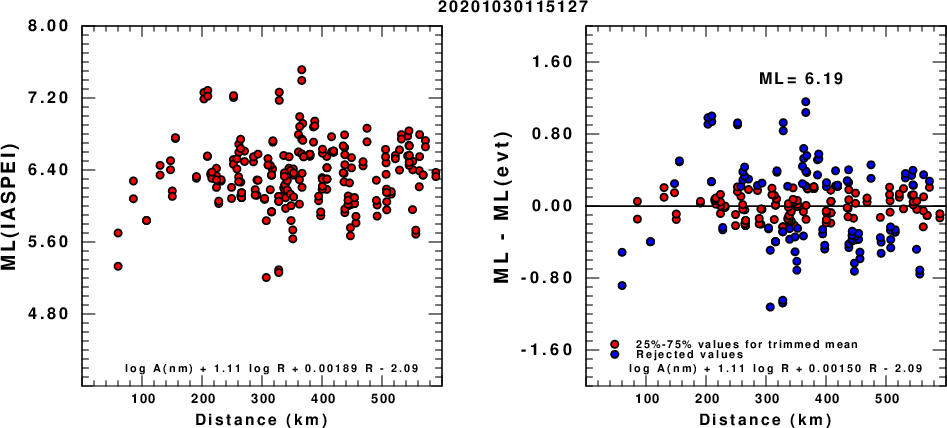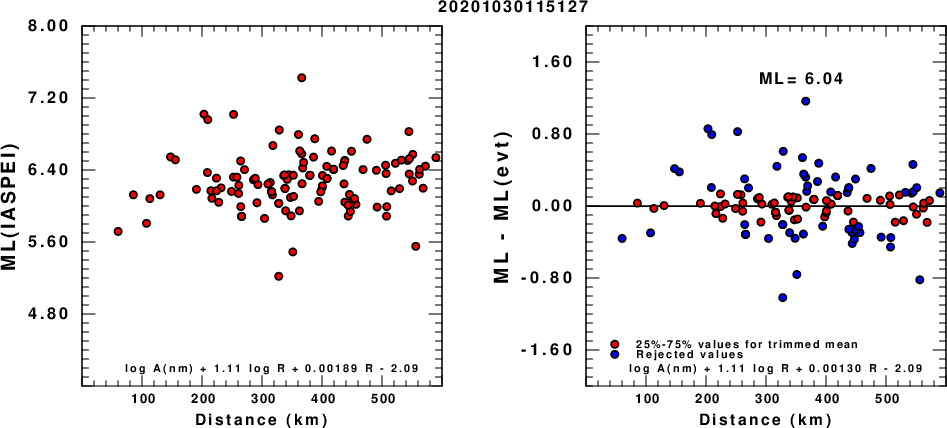Location
Location ANSS
2020/10/30 11:51:27 37.918 26.790 21.0 7.0 Greece
Focal Mechanism
USGS/SLU Moment Tensor Solution
ENS 2020/10/30 11:51:27:0 37.92 26.79 21.0 7.0 Greece
Stations used:
GE.CSS HL.ATH HL.EVR HL.GVD HL.IACM HL.ITM HL.KARP HL.KLV
HL.KSL HL.KTHA HL.KZN HL.NEO HL.NVR HL.SIVA HL.SKY HL.SMTH
HL.TETR HL.VAM HL.VLY HT.AGG HT.ALN HT.AOS2 HT.EVGI HT.GRG
HT.KAVA HT.KNT HT.KPRO HT.NEST HT.OUR HT.PAIG HT.RTZL
HT.SOH HT.SRS HT.THAS HT.THE HT.TYRN HT.XOR KO.AFSR KO.ARMT
KO.BALB KO.BGKT KO.CTYL KO.EDC KO.GEML KO.HDMB KO.ISK
KO.KAMT KO.KAVV KO.KCTX KO.KIZT KO.KONT KO.KULU KO.KURC
KO.LADK KO.LFK KO.LOD KO.RKY KO.RUZG KO.SAUV KO.SDAG
KO.SHUT KO.SILT KO.SVRH KO.YALI KO.YLV MN.ISP MN.KEK MN.THL
Filtering commands used:
cut o DIST/3.3 -80 o DIST/3.3 +150
rtr
taper w 0.1
hp c 0.01 n 3
lp c 0.02 n 3
Best Fitting Double Couple
Mo = 2.37e+26 dyne-cm
Mw = 6.85
Z = 8 km
Plane Strike Dip Rake
NP1 268 45 -95
NP2 95 45 -85
Principal Axes:
Axis Value Plunge Azimuth
T 2.37e+26 0 1
N 0.00e+00 4 271
P -2.37e+26 86 93
Moment Tensor: (dyne-cm)
Component Value
Mxx 2.37e+26
Mxy 6.12e+24
Mxz 1.27e+24
Myy -7.43e+23
Myz -1.46e+25
Mzz -2.36e+26
###### T #####
########## #########
############################
##############################
##################################
###########---------------##########
#######-------------------------######
#####-------------------------------####
###-----------------------------------##
##--------------------------------------##
----------------------- ----------------
##--------------------- P ----------------
###-------------------- ---------------#
####-----------------------------------#
######------------------------------####
########-------------------------#####
############---------------#########
##################################
##############################
############################
######################
##############
Global CMT Convention Moment Tensor:
R T P
-2.36e+26 1.27e+24 1.46e+25
1.27e+24 2.37e+26 -6.12e+24
1.46e+25 -6.12e+24 -7.43e+23
Details of the solution is found at
http://www.eas.slu.edu/eqc/eqc_mt/MECH.NA/20201030115127/index.html
|
Preferred Solution
The preferred solution from an analysis of the surface-wave spectral amplitude radiation pattern, waveform inversion and first motion observations is
STK = 95
DIP = 45
RAKE = -85
MW = 6.85
HS = 8.0
The NDK file is 20201030115127.ndk
The waveform inversion is preferred.
Moment Tensor Comparison
The following compares this source inversion to others
| SLU |
USGS/SLU Moment Tensor Solution
ENS 2020/10/30 11:51:27:0 37.92 26.79 21.0 7.0 Greece
Stations used:
GE.CSS HL.ATH HL.EVR HL.GVD HL.IACM HL.ITM HL.KARP HL.KLV
HL.KSL HL.KTHA HL.KZN HL.NEO HL.NVR HL.SIVA HL.SKY HL.SMTH
HL.TETR HL.VAM HL.VLY HT.AGG HT.ALN HT.AOS2 HT.EVGI HT.GRG
HT.KAVA HT.KNT HT.KPRO HT.NEST HT.OUR HT.PAIG HT.RTZL
HT.SOH HT.SRS HT.THAS HT.THE HT.TYRN HT.XOR KO.AFSR KO.ARMT
KO.BALB KO.BGKT KO.CTYL KO.EDC KO.GEML KO.HDMB KO.ISK
KO.KAMT KO.KAVV KO.KCTX KO.KIZT KO.KONT KO.KULU KO.KURC
KO.LADK KO.LFK KO.LOD KO.RKY KO.RUZG KO.SAUV KO.SDAG
KO.SHUT KO.SILT KO.SVRH KO.YALI KO.YLV MN.ISP MN.KEK MN.THL
Filtering commands used:
cut o DIST/3.3 -80 o DIST/3.3 +150
rtr
taper w 0.1
hp c 0.01 n 3
lp c 0.02 n 3
Best Fitting Double Couple
Mo = 2.37e+26 dyne-cm
Mw = 6.85
Z = 8 km
Plane Strike Dip Rake
NP1 268 45 -95
NP2 95 45 -85
Principal Axes:
Axis Value Plunge Azimuth
T 2.37e+26 0 1
N 0.00e+00 4 271
P -2.37e+26 86 93
Moment Tensor: (dyne-cm)
Component Value
Mxx 2.37e+26
Mxy 6.12e+24
Mxz 1.27e+24
Myy -7.43e+23
Myz -1.46e+25
Mzz -2.36e+26
###### T #####
########## #########
############################
##############################
##################################
###########---------------##########
#######-------------------------######
#####-------------------------------####
###-----------------------------------##
##--------------------------------------##
----------------------- ----------------
##--------------------- P ----------------
###-------------------- ---------------#
####-----------------------------------#
######------------------------------####
########-------------------------#####
############---------------#########
##################################
##############################
############################
######################
##############
Global CMT Convention Moment Tensor:
R T P
-2.36e+26 1.27e+24 1.46e+25
1.27e+24 2.37e+26 -6.12e+24
1.46e+25 -6.12e+24 -7.43e+23
Details of the solution is found at
http://www.eas.slu.edu/eqc/eqc_mt/MECH.NA/20201030115127/index.html
|
Magnitudes
ML Magnitude

(a) ML computed using the IASPEI formula for Horizontal components; (b) ML residuals computed using a modified IASPEI formula that accounts for path specific attenuation; the values used for the trimmed mean are indicated. The ML relation used for each figure is given at the bottom of each plot.

(a) ML computed using the IASPEI formula for Vertical components (research); (b) ML residuals computed using a modified IASPEI formula that accounts for path specific attenuation; the values used for the trimmed mean are indicated. The ML relation used for each figure is given at the bottom of each plot.
Context
The next figure presents the focal mechanism for this earthquake (red) in the context of other events (blue) in the SLU Moment Tensor Catalog which are within ± 0.5 degrees of the new event. This comparison is shown in the left panel of the figure. The right panel shows the inferred direction of maximum compressive stress and the type of faulting (green is strike-slip, red is normal, blue is thrust; oblique is shown by a combination of colors).
Waveform Inversion
The focal mechanism was determined using broadband seismic waveforms. The location of the event and the
and stations used for the waveform inversion are shown in the next figure.

|
|
Location of broadband stations used for waveform inversion
|
The program wvfgrd96 was used with good traces observed at short distance to determine the focal mechanism, depth and seismic moment. This technique requires a high quality signal and well determined velocity model for the Green functions. To the extent that these are the quality data, this type of mechanism should be preferred over the radiation pattern technique which requires the separate step of defining the pressure and tension quadrants and the correct strike.
The observed and predicted traces are filtered using the following gsac commands:
cut o DIST/3.3 -80 o DIST/3.3 +150
rtr
taper w 0.1
hp c 0.01 n 3
lp c 0.02 n 3
The results of this grid search from 0.5 to 19 km depth are as follow:
DEPTH STK DIP RAKE MW FIT
WVFGRD96 1.0 285 50 -65 6.65 0.4424
WVFGRD96 2.0 110 50 -60 6.69 0.4903
WVFGRD96 3.0 105 50 -70 6.73 0.5395
WVFGRD96 4.0 95 45 -85 6.76 0.5799
WVFGRD96 5.0 95 45 -85 6.79 0.6090
WVFGRD96 6.0 95 45 -85 6.82 0.6243
WVFGRD96 7.0 95 45 -85 6.83 0.6266
WVFGRD96 8.0 95 45 -85 6.85 0.6519
WVFGRD96 9.0 95 45 -85 6.86 0.6407
WVFGRD96 10.0 95 45 -85 6.86 0.6169
WVFGRD96 11.0 95 45 -85 6.86 0.5842
WVFGRD96 12.0 95 45 -85 6.86 0.5442
WVFGRD96 13.0 270 45 -95 6.85 0.4999
WVFGRD96 14.0 95 45 -85 6.84 0.4580
WVFGRD96 15.0 105 45 -70 6.81 0.4190
WVFGRD96 16.0 135 65 -20 6.74 0.4070
WVFGRD96 17.0 135 70 -20 6.73 0.4012
WVFGRD96 18.0 135 70 -20 6.73 0.3962
WVFGRD96 19.0 140 70 5 6.73 0.3930
WVFGRD96 20.0 140 70 5 6.74 0.3917
WVFGRD96 21.0 140 70 10 6.74 0.3896
WVFGRD96 22.0 140 70 10 6.75 0.3892
WVFGRD96 23.0 140 70 15 6.75 0.3897
WVFGRD96 24.0 140 70 15 6.76 0.3909
WVFGRD96 25.0 140 70 15 6.76 0.3924
WVFGRD96 26.0 140 70 15 6.77 0.3938
WVFGRD96 27.0 140 70 15 6.77 0.3955
WVFGRD96 28.0 140 70 15 6.78 0.3974
WVFGRD96 29.0 140 70 20 6.78 0.3999
The best solution is
WVFGRD96 8.0 95 45 -85 6.85 0.6519
The mechanism correspond to the best fit is

|
|
Figure 1. Waveform inversion focal mechanism
|
The best fit as a function of depth is given in the following figure:

|
|
Figure 2. Depth sensitivity for waveform mechanism
|
The comparison of the observed and predicted waveforms is given in the next figure. The red traces are the observed and the blue are the predicted.
Each observed-predicted component is plotted to the same scale and peak amplitudes are indicated by the numbers to the left of each trace. A pair of numbers is given in black at the right of each predicted traces. The upper number it the time shift required for maximum correlation between the observed and predicted traces. This time shift is required because the synthetics are not computed at exactly the same distance as the observed and because the velocity model used in the predictions may not be perfect.
A positive time shift indicates that the prediction is too fast and should be delayed to match the observed trace (shift to the right in this figure). A negative value indicates that the prediction is too slow. The lower number gives the percentage of variance reduction to characterize the individual goodness of fit (100% indicates a perfect fit).
The bandpass filter used in the processing and for the display was
cut o DIST/3.3 -80 o DIST/3.3 +150
rtr
taper w 0.1
hp c 0.01 n 3
lp c 0.02 n 3

|
|
Figure 3. Waveform comparison for selected depth
|

|
|
Focal mechanism sensitivity at the preferred depth. The red color indicates a very good fit to thewavefroms.
Each solution is plotted as a vector at a given value of strike and dip with the angle of the vector representing the rake angle, measured, with respect to the upward vertical (N) in the figure.
|
A check on the assumed source location is possible by looking at the time shifts between the observed and predicted traces. The time shifts for waveform matching arise for several reasons:
- The origin time and epicentral distance are incorrect
- The velocity model used for the inversion is incorrect
- The velocity model used to define the P-arrival time is not the
same as the velocity model used for the waveform inversion
(assuming that the initial trace alignment is based on the
P arrival time)
Assuming only a mislocation, the time shifts are fit to a functional form:
Time_shift = A + B cos Azimuth + C Sin Azimuth
The time shifts for this inversion lead to the next figure:

The derived shift in origin time and epicentral coordinates are given at the bottom of the figure.
Discussion
Acknowledgements
Thanks also to the many seismic network operators whose dedication make this effort possible: University of Nevada Reno, University of Alaska, University of Washington, Oregon State University, University of Utah, Montana Bureas of Mines, UC Berkely, Caltech, UC San Diego, Saint Louis University, University of Memphis, Lamont Doherty Earth Observatory, the Iris stations and the Transportable Array of EarthScope.
Velocity Model
The WUS.model used for the waveform synthetic seismograms and for the surface wave eigenfunctions and dispersion is as follows:
MODEL.01
Model after 8 iterations
ISOTROPIC
KGS
FLAT EARTH
1-D
CONSTANT VELOCITY
LINE08
LINE09
LINE10
LINE11
H(KM) VP(KM/S) VS(KM/S) RHO(GM/CC) QP QS ETAP ETAS FREFP FREFS
1.9000 3.4065 2.0089 2.2150 0.302E-02 0.679E-02 0.00 0.00 1.00 1.00
6.1000 5.5445 3.2953 2.6089 0.349E-02 0.784E-02 0.00 0.00 1.00 1.00
13.0000 6.2708 3.7396 2.7812 0.212E-02 0.476E-02 0.00 0.00 1.00 1.00
19.0000 6.4075 3.7680 2.8223 0.111E-02 0.249E-02 0.00 0.00 1.00 1.00
0.0000 7.9000 4.6200 3.2760 0.164E-10 0.370E-10 0.00 0.00 1.00 1.00
Quality Control
Here we tabulate the reasons for not using certain digital data sets
The following stations did not have a valid response files:
Last Changed Tue Nov 24 16:19:32 CST 2020








